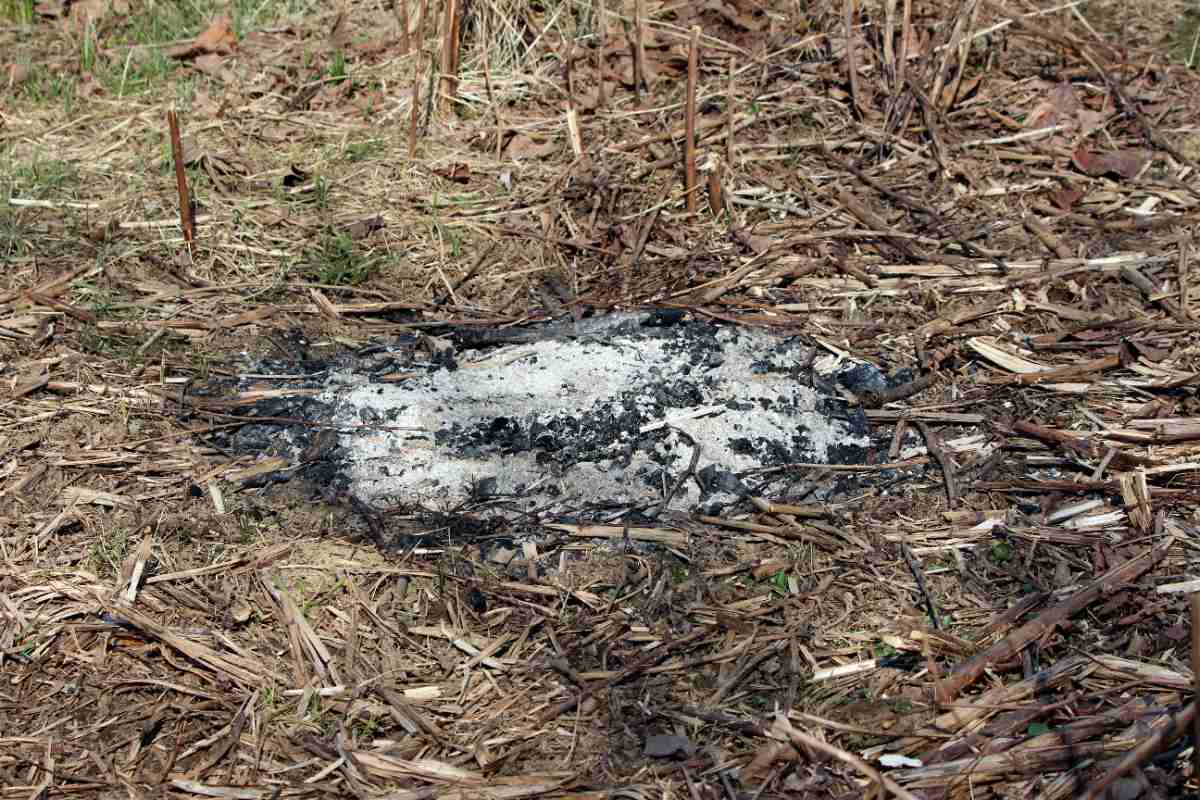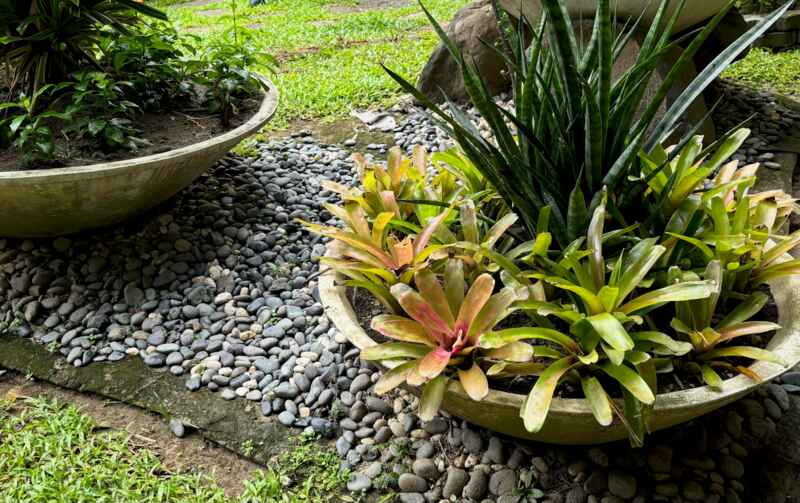
Mulch is intended to protect plants, but it can pose a hazard to your property if it catches fire. To prevent mulch fires, create fire-safe zones and incorporate fire-resistant, inorganic mulch, like gravel and rock, in your landscape.
As a landscape designer, I understand the significant dangers of mulch fires, but I also know how to minimize this risk. I’ll walk you through simple choices and techniques to use mulch safely and avoid mulch fires around your home.
Ways to Prevent Mulch Fires
To reduce the risk of mulch fires, keep mulch at the proper depth, establish safe zones around your home, and prioritize maintenance in your mulched beds (water regularly and remove debris).
Maintain Proper Mulch Depth

To prevent mulch fires, keep organic mulch at a depth of between 2 and 3 inches. Piling it deeper than 6 inches in hot, dry conditions can lead to excessive heat buildup, restrict airflow, and increase the risk of ignition.
See Related: How to Mulch Your Yard: A Step-by-Step Guide
Establish Safe Zones Around Structures
To minimize the risk of mulch fires spreading to your home and surrounding vegetation, especially in wildfire-prone regions, your township and/or state may have implemented defensible space guidelines like the ones below.
- Establish a noncombustible zone: Create a 5-foot barrier around all structures using nonflammable materials, including rock mulches, to prevent ember ignition, especially in wildfire-prone areas.
- Avoid highly flammable mulch, including shredded rubber, pine needles, and cedar bark or shredded western red cedar, within 30 feet of your home and near structures, as it can pose a fire hazard.
| Note: Along the East Coast, a less stringent approach may be more common. For example, Massachusetts requires only an 18-inch space between new organic mulch and certain residential structures, particularly those with wood or vinyl siding. If you’d like to have a pro help you create defensible space around your home, hire one of LawnStarter’s local landscaping pros to transport and spread mulch, install firewise plants, and keep your home safe during wildfire season. |
Utilize Firescaping

Firescaping, or fire-resistant landscaping, is a landscaping technique that minimizes ignition risk to protect homes from wildfires. This method emphasizes a “Lean, Clean, and Green” zone within 5-30 feet of your house.
To reduce the risk of mulch fires around your home, follow these key firescaping principles:
- Choose plants with a higher moisture content: Herbaceous plants (without woody stems), such as shorter ornamental grasses, flowers, bulbs, and succulents, fall into this category.
- Avoid flammable plants: Evergreens like pine trees should be avoided due to their flammable oils, resins, and waxes.
- Incorporate inorganic elements: Water features, inorganic mulch (like stone or rocks), hardscaping, and xeriscaping help lower fire risk in your landscape.
- Separate mulched areas: If you use organic mulches in the “Lean, Clean, and Green” zone, use them in small “islands” surrounded by sections with noncombustible materials, such as concrete hardscaping or low flammability plants, like succulents.
| Note: The University of Nevada Cooperative Extension notes that composted wood chips are less flammable than pine needles and cedar but still combustible, so use them at least 5 feet from your home’s foundation. |
See Related:
Choose Inorganic Stone Mulch

Protecting your yard from fire can be simple with the right materials. Using inorganic mulch from stones or rocks — like pea gravel, red tipple, lava rock, gravel, or even large boulders — helps reduce the risk of ignition around your home, especially near gas meters, vents, and foundations.
Hardscape areas such as patios, walkways, and driveways also act as natural fire breaks while adding style and structure to your landscape.
| My Experience: Inorganic mulches like red tipple stone are coarse and angular, making them ideal for pathways and driveways. They also add a rich burgundy accent to garden beds. Small pea gravel, with its smooth, round stones, works better in garden beds but tends to shift underfoot. |
Discard Cigarettes Properly
The National Fire Protection Association reports that nearly half of the thousands of mulch fires reported annually are associated with improperly discarded smoking materials. To help prevent these fires, set up a designated container filled with sand near the door where you smoke, instead of throwing cigarette butts into mulch or potted plants.
Install an Irrigation System
To lower the risk of mulch fires and support plant health, install and maintain a drip line or nozzle irrigation system directed at mulched areas to keep the soil and surrounding materials moist.
See Related:
Avoid Mulch Volcanoes
There is a common misconception that piling mulch in a “volcano” around a tree will protect it from lawnmower damage and make it look more aesthetically pleasing. However, instead of protecting the tree, it suffocates the tree’s roots and stresses the tree. Additionally, in extended hot, dry, windy weather, the thickly piled mulch can overheat and even ignite if exposed to a lit cigarette.
To mulch around trees the right way, use no more than 3 inches of mulch in a 3-foot ring around the base of the tree. This promotes tree health and helps prevent mulch fires.
Conduct Regular Inspections and Maintenance
Regularly inspect and maintain your organic mulch to reduce your risk of mulch fires. Here are some tips:
- Monitor environmental conditions like dry spells, high temperatures (above 86 F), strong winds, and nearby wildfires. These increase the fire risk for organic mulches when humidity is below 30%. In these conditions, water your mulched beds consistently and early in the morning.
- Clean up lawn debris, dead leaves, old branches, and sap-covered pine needles that build up on organic mulch, particularly near a house’s foundation, especially for homes with wood or vinyl siding.
- Avoid having an organic mulch pile on your property. If you have a load of mulch delivered, try to spread it across landscaped areas the same day.
FAQ
During hot, dry weather or extended droughts, water mulch 3 times per week to keep it slightly moist. The best time is early morning, between 4 a.m. and 7 a.m., when evaporation is minimal. Installing a sprinkler system with automated timers can save water and make maintenance effortless — set it and forget it.
Yes. Tests carried out by Consumer Reports revealed that rubber mulch caught fire faster and burned at higher temperatures compared to wood mulch.
No. Many types of landscape fabric are flammable and may worsen the situation by separating the mulch from the soil, hindering decomposition, and increasing fire risk.
Create Your Own Fire-Safe Yard
With some simple planning and a little effort, you can enjoy your own fire-safe yard that’s both beautiful and protected. And if you’d like an extra hand along the way, local LawnStarter landscaping pros are here to spread and maintain mulch throughout the year.
Read More:
Sources:
- “Assessing the Options to Reduce the Fire Risk of Mulch Landscaping.” By Stephen Morris, captain for the Harrisonburg Fire Department. United States Fire Administration.
- “CMG GardenNotes #245: Mulching.” By Extension experts David Whiting, Carl Wilson, Catherine Moravec, Jean Reeder, and Eric Hammond. Colorado State University Extension.
- “Combating and Preventing Mulch Fires.” Fire Engineering.
- “Fire Smart Landscape Basics.” Fire Safe Marin.
- “Hort Notes: Beware of Sour Mulch.” By Amanda Bayer, sustainable landscape horticulture expert. UMass Extension.
- “How to Use Fire-Resistant Mulch.” Fire Safe Marin.
- “Mulch.” UC ANR Fire Network.
- “Mulch Fires Are More Common Than You Think.” Montgomery Township.
- “Mulch Fire Safety.” Middletown, RI.
- “Mulch, Fire Safety and the Myth of Spontaneous Combustion.” ChromaScape.
- “Mulch Tests: Rubber Stacks Up Well Against Wood.” Consumer Reports.
- “Research Study Douses Claims of Mulch Spontaneous Combustion.” Soil & Mulch Producer News.
- “Seasonal Safety Reminder: Be Aware of Mulch Fire Hazards.” Department of Fire Services. Mass.gov.
- “The Combustibility of Landscape Mulches.” By Stephen Quarles, wood performance and durability advisor, and Ed Smith, natural resource specialist. University of Nevada Cooperative Extension.
- “The Dangers Associated With Landscaping Material Fires.” By Andrew Bennett, fire and explosion investigation expert. Envista Forensics.
Main Image: Mulch fire. Photo Credit: hecos / Adobe Stock